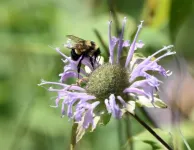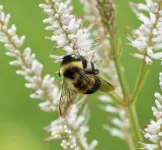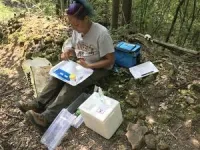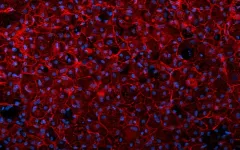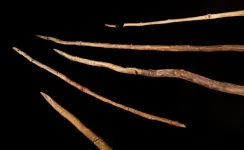(Press-News.org) A team of researchers has uncovered alarming trends in the first range-wide genetic study of an endangered bee species. The study, led by Colorado State University and published in the Journal of Insect Science, will inform conservation and recovery efforts for the rusty-patched bumblebee – a species that was once common in the United States but has declined from about 90% of its historic range.
The rusty-patched bumblebee was the first bee species to be federally listed as endangered in 2017 through the U.S. Endangered Species Act. Its numbers dropped rapidly starting in the late 1990s, likely due to a combination of pesticides, pathogens, habitat loss and degradation, and climate change.
"If that trajectory continues, this species could blink out in the next couple decades,” said lead author John Mola, an ecologist and assistant professor of forest and rangeland stewardship.
The outlook is dire for remaining populations of this important pollinator, according to the in-depth genetic examination by a large team of collaborators, including federal and state agencies, universities, nonprofits and consultants.
Even in strongholds where the bee is still found, scientists observed fewer colonies than a stable species would have and a high rate of inbreeding, which can threaten the long-term viability of a species. Of the bees sampled, 15% showed evidence of inbreeding, through the presence of what are called diploid males. In bees, males are typically haploid and have only one set of chromosomes, but when they're inbred, they can have two sets of the same chromosomes and lack genetic diversity.
"When that happens, those populations essentially face a death sentence," Mola said. “They basically have incompatible genetic systems with other populations of the same species."
Analysis revealed three genetically distinct populations among rusty-patched bumblebees – in the upper Midwest, central Midwest and Appalachians – that will need to be handled differently for potential recovery efforts. Understanding population differentiation is key for captive rearing programs because bees from different populations might not be genetically compatible or might not survive once they’re released into the wild.
“This research is invaluable – it helps us refine healthy colony targets and shows us the importance of optimizing conservation efforts in genetically distinct areas, like the Appalachians,” said co-author Tamara Smith, a wildlife biologist with the U.S. Fish and Wildlife Service.
Protecting pollinators
Pollinators, including bumblebees, are critical for food production and support many other species. Pollinators improve ecosystem health and resilience, and many crops and flowering plants depend on them.
"There are approximately 50 species of bumblebee in North America, but there are big differences between bumblebees in the same way that there are big differences between songbirds and hawks,” Mola said. “They're not substitutable."
Decline of the rusty-patched bumblebee could be a harbinger of die-offs of other species that were once common.
"Unfortunately, we're looking at a future scenario where about one in five bumblebee species in the United States could be endangered,” Mola continued.
But there is hope.
The rusty-patched bumblebee’s endangered listing has led to programs that restore habitat and the bee's preferred plants. Pollinator-friendly home and community gardens make a difference, too, Mola said.
"At times, there can be doom and gloom in conservation, but there are good examples of butterfly species that have been recovered through careful conservation planning,” he added. “The same thing applies with bumblebees.”
Additionally, restoration projects that benefit bumblebees benefit other wildlife and landscape health in general.
Project partners, process
Surveying the rusty-patched bumblebee across its entire U.S. range required a vast network of collaborators with proper permits to collect genetic samples from the endangered species. Sampling involved catching the bees in nets, briefly putting them on ice and clipping off a tiny bit of leg – enough to conduct the study but not so much that it would interfere with their ability to function.
“Numerous partners recognized the importance of collecting these data, and we thank them for their contributions,” Smith said.
The project was mostly funded by the U.S. Geological Survey Science Support Partnership and the Great Lakes Restoration Initiative’s Threatened and Endangered Species Template through the U.S. Fish and Wildlife Service. The study was led by authors Mola, Smith, Ian Pearse (USGS), Michelle Boone (University of Minnesota), Elaine Evans (University of Minnesota), Mark Hepner (Metamorphic Ecological Research and Consulting), Robert Jean (Environmental Solutions and Innovations), Jade Kochanski (University of Wisconsin–Madison), Cale Nordmeyer (Minnesota Zoo), Erik Runquist (Minnesota Zoo), James Strange (Ohio State University), Jay Watson (Wisconsin Department of Natural Resources) and Jonathan Koch (U.S. Department of Agriculture).
END
Rusty-patched bumblebee’s struggle for survival found in its genes
2024-04-04
ELSE PRESS RELEASES FROM THIS DATE:
Research collaboration aims to enhance cereal crop resilience to acidic soils and improve agriculture sustainability
2024-04-04
ST. LOUIS, MO., April 4, 2024 — Acidic soil caused by changing climate patterns threatens agriculture sustainability across the globe. But the problem goes far beyond rising temperatures. One major cause for concern is more acidic soil, a product of increasing rainfall. Acidic soils with low pH are widespread globally and common in tropical and sub-tropical regions, where food security is a serious challenge. Climate change has exacerbated the problem. Acidic soil can result in aluminum toxicity, putting further stress on global agriculture. A new collaborative research team from the US and Brazil received a $2 ...
Introducing New York Valves: The Structural Heart Summit
2024-04-04
NEW YORK – April 4, 2024 – The Cardiovascular Research Foundation® (CRF®) is excited to introduce New York Valves: The Structural Heart Summit, the expanded next iteration of our renowned annual Transcatheter Valve Therapy (TVT®) conference. Taking place June 5-7, 2024, at the Jacob K. Javits Convention Center, North in New York City, the new summit will be a world-class educational experience in the field of structural heart interventions.
“New York Valves 2024 signifies an important milestone for our organization,” said Juan F. Granada, MD, President and Chief Executive Officer of CRF® and New York ...
"Drop industrial agriculture": Major study reports that people and environment both benefit from diversified farming, while bottom lines also thrive
2024-04-04
Mixing livestock and crops, integrating flower strips and trees, water and soil conservation and much more: Massive new global study led by the University of Copenhagen and University of Hohenheim, has examined the effects of diversified agriculture. The conclusion is abundantly clear – positive effects increase with every measure, while negative effects are hard to find.
Laura Vang Rasmussen of the University of Copenhagen can finally wipe the sweat from her brow. For the last four years, she has served as the link between 58 researchers on five continents and as lead author of a major agricultural study which gathered ...
Portable swept-source Raman spectrometer for chemical and biomedical applications
2024-04-04
In 1928, Indian physicist Sir C. V. Raman and his colleague K. S. Krishnan discovered that when light interacts with matter, parts of the scattered light undergo changes in energy due to interaction with molecular vibrations, resulting in what is known as Raman scattering. The discovery laid the foundation for Raman spectroscopy, a technique that takes advantage of these energy changes to create a unique fingerprint of the molecular structure of the material.
Currently, dispersive Raman spectroscopy ...
An hereditary liver disease cured with the help of gene scissors
2024-04-04
Argininosuccinate lyase deficiency (ASLD), also known as argininosuccinic aciduria, is a disease that has been enriched in the Finnish genetic heritage. In this severe metabolic disease, the body does not process proteins normally, instead resulting in a very dangerous accumulation of argininosuccinic acid and ammonia. Excess ammonia causes disturbances of consciousness, coma and even death.
In Finland, infants are screened for ASLD to determine the disease risk before symptoms develop. The treatment is an extremely ...
Dr. C. Barrett Bowling to be honored with the 2024 Thomas and Catherine Yoshikawa Outstanding Scientific Achievement in Clinical Investigation Award at #AGS24
2024-04-04
New York (April 4, 2024) — Today, the American Geriatrics Society (AGS) and the AGS Health in Aging Foundation (HiAF) announced that the 2024 Thomas and Catherine Yoshikawa Award for Outstanding Scientific Achievement in Clinical Investigation will be awarded to C. Barrett Bowling, MD, MSPH, Associate Professor in the Division of Geriatrics at Duke University School of Medicine.
The award will be presented at the AGS 2024 Virtual Annual Scientific Meeting (#AGS24), May 9-11 (pre-conference days May 7 & 8). At the conference, Dr. Bowling will deliver a lecture on “Geriatricizing” Chronic Disease Research: A Geriatrician’s ...
Finds at Schöningen show wood was crucial raw material 300,000 years ago
2024-04-04
During archaeological excavations in the Schöningen open-cast coal mine in 1994, the discovery of the oldest, remarkably well-preserved hunting weapons known to humanity caused an international sensation. Spears and a double-pointed throwing stick were found lying between animal bones about ten meters below the surface in deposits at a former lakeshore. In the years that followed, extensive excavations have gradually yielded numerous wooden objects from a layer dating from the end of a warm interglacial period 300,000 years ago. The findings suggested a hunting ground on the lakeshore. An interdisciplinary ...
Cells engineered to produce immune-boosting amino acids in prizewinning research
2024-04-04
Bacterial proteins often play a successful hide and seek game with the body’s immune system, making it difficult to combat the bacteria that cause diseases like staph infections.
Now, biomolecular engineer Aditya Kunjapur and colleagues have come up with a strategy to create bacteria that build and incorporate a key amino acid into their own proteins, which makes the proteins more “visible” to the immune system.
For this work toward building a better platform for possible future bacterial vaccines, Kunjapur is the winner of the 2024 BioInnovation Institute & Science Prize for Innovation. ...
Flexible fiber, coupled to the human body, enables chipless textile electronics
2024-04-04
A flexible electronic fiber that utilizes the human body as part of the circuit enables textile-based electronics without the need for batteries or chips, researchers report. According to the authors, the approach is well-suited for scalable manufacture of comfortable fiber-based electronics for a wide range of applications, including “smart” clothing. Textile electronic systems are designed to equip textile or fiber assemblies with electronic functions for sensing, computation, display, or communication. They create vast opportunities ranging from physiological monitoring to powering ...
Governance frameworks should address the prospect of AI systems that cannot be safely tested
2024-04-04
In this Policy Forum, Michael Cohen and colleagues highlight the unique risks presented by a particular class of artificial intelligence (AI) systems: reinforcement learning (RL) agents that plan more effectively than humans over long horizons. “Giving [such] an advanced AI system the objective to maximize its reward and, at some point, withholding reward from it, strongly incentivizes the AI system to take humans out of the loop,” write Cohen and colleagues. This incentive also arises for long-term planning agents (LTPAs) more generally, say the authors, and in ways empirical testing is unlikely to cover. It is thus critical to address extinction risk from these ...
